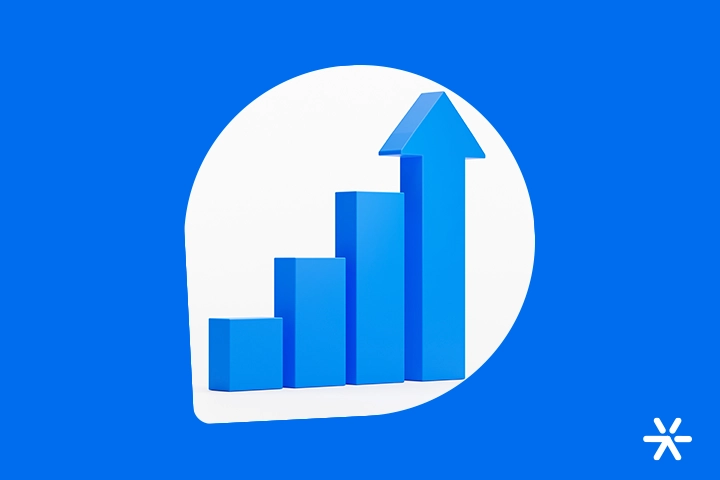Content Marketing in 2025: What’s Changing and Effective Strategies
Is It Worth Starting Content Marketing in 2025? Finding the answer is simple: open your Instagram, go to YouTube, or ask Google something. Do you see the results? Those are the fruits of content marketing.
And those fruits are being harvested now, but they were planted weeks, months, or even years ago. That’s what content marketing is all about: you need to start as early as possible to reap the rewards in the long term.
Actually, not just in the long term. Many people think content marketing is just article after article, with the main focus on bringing more visitors to your website through Google.
But Google is just one tool. So are YouTube, Instagram, Facebook, Reddit, LinkedIn, and every other social media platform. Content is everywhere.
This article is here to dive deeper into content marketing — what it is, where it happens, and what kind of results it delivers. We’ll also talk a bit about how to implement the strategy and how to keep improving it.
Starting from the beginning:
What Is Content Marketing?

You might still be unsure about the definition of content marketing, but you definitely know what content itself is.
Nowadays, with the internet accessible to nearly everyone, content is everywhere. The Oxford Dictionary defines content as:
“A subject or set of subjects covered in a book, letter, document, advertisement, etc.; topic.”
Content is a video, a social media post, an e-book, a book, a TV show, and more. Content is the work of gathering information and presenting it to your customer base, followers, or leads.
That content always needs to be relevant to whoever’s consuming it — if it isn’t, no one will engage with it.
Content marketing is the action of creating that content: identifying your audience, brainstorming topics and keywords, producing content at scale, and distributing it across your available channels.
Those channels can include social media, podcasts, Google (through SEO), YouTube, and more.
The content is created to attract more and more interested people — and turn them into an audience.
From there, it becomes easier to distribute your advertising messages, since you’ll be talking to people who are already interested in your topics — which makes closing new sales much easier.
Many people think content marketing began with the rise of the internet. But these tactics go way back. Television itself is a form of content marketing: the more people watch the programming, the more people see the commercials.
And even television wasn’t the original inventor of content marketing. Here are some of the earliest known examples:
What Were the First Content Marketing Initiatives?
The first known example of content marketing was launched in 1895 by John Deere. It was a magazine called The Furrow, aimed at farmers, and it’s still in circulation today.
The Furrow featured tips, weather forecasts, and stories about agriculture. Although it was produced by John Deere, it wasn’t a magazine just to promote its products — those were shown in ads and a few editorials.
The Furrow didn’t reign alone for long. Five years later, in 1900, Michelin launched the first edition of the Michelin Guide, a publication that introduced the concept of ranking restaurants with stars.
The best received three stars, and even those with just one star were proud to be listed.
The cover text already made the intent of content marketing clear: “offered graciously to drivers.” The idea was (and still is — the guide is still published) to help drivers find good restaurants in Paris and throughout Europe.
Here we clearly see the main intent of content marketing: helping everyday people — whether they’re customers of the brand or not. But the focus is actually on those who are not yet customers.
Imagine a farmer unfamiliar with John Deere: their first contact with the brand wasn’t an ad, but a helpful publication.
Another interesting example to wrap up this topic: in the U.S., what we call “soap operas” got their name because in 1933, Procter & Gamble invented the format as a content strategy to promote its soap brand.
Content Marketing as an Inbound Marketing Strategy
The first efforts to understand the buyer’s journey can be attributed to Sears, back at the end of the 19th century.
The American retail giant conducted research to understand what its customers needed, purchased products for resale, and distributed catalogs across the country. Deliveries were made by train.
But while understanding the buyer’s journey is fundamental to inbound marketing, the strategy only received that name and became a methodology with the birth of HubSpot in 2006.
HubSpot completely transformed the marketing world. At the time, it introduced a truly revolutionary concept: brands shouldn’t chase after customers by interrupting them with ads or TV commercials. Instead, customers should seek out the brand.
And for that to happen, content marketing is key. Why would customers be interested in a brand beyond the products it sells? Because, in addition to selling, it also produces content.
This content, when useful, informative, interesting, or entertaining, attracts people who often don’t even realize a brand is behind the production.
That first contact—called attraction in the inbound sales funnel proposed by HubSpot (see below)—draws the attention of potential customers to the brand. The next step is to turn them into leads, and then close the sale.
🔎 Also read: Top of the Funnel – Strategies and Content for This Stage of Sales
Omnichannel Content Marketing
Back in 2006, most companies did content marketing mainly through blogs. Blogs are similar to the publications we mentioned earlier—The Furrow and the Michelin Guide.
By sharing their specialized knowledge through a blog, brands began attracting thousands of people to their websites—this is the attraction stage defined by HubSpot.
With simple forms and increasingly in-depth content, these brands started converting those visitors into leads: they would leave their contact details to access new materials or request a quote.
That changed significantly with the widespread adoption of content creation on social media, YouTube, and other platforms. Instead of producing content only for their blog, brands began spreading their content across channels, multiplying their number of visitors—and therefore, leads.
That’s how it works today. Blogs still exist, but content production is now omnichannel, present practically everywhere people gather.
What Is the Goal of Content Marketing?

So far, it’s clear that the main goal of content marketing is to generate visitors and attract people interested in your brand. This is usually done through an inbound marketing strategy in conjunction with content.
But here’s a great opportunity to dig a little deeper into these goals by introducing you to some metrics you need to monitor for your content marketing in 2025.
Let’s talk about these:
- Increase in website traffic
- Lead generation
- Brand relationship building
- Expanding your reach
- Brand authority
If you take a closer look, the stages of the inbound sales funnel are clearly defined here: attract (traffic), convert and close (generate leads and sales), and delight (relationship).
Starting at the Top of the Funnel:
Increase Website Traffic
We’re talking about websites because, today, content marketing and inbound marketing are digital strategies.
They don’t have to be—as we saw with the Michelin Guide and The Furrow—but nowadays, the cost to start a digital marketing strategy is so accessible that there’s little reason to focus on traditional models like print media.
Content marketing works by attracting people to your website mainly through blogs and exclusive materials that can only be found there.
In the case of blogs, the work involves identifying topics related to your business with high search volume. This is where keyword research comes in—platforms like Semrush, Google Keyword Planner, and Ubersuggest are used.
By finding specific keywords—like the one in this very article, content marketing—you can analyze the results provided by the tool and create a better article to appear in a higher position on Google’s first page.
Once people are visiting your website, you build a loyal audience without needing to invest in ads, for example.
In other cases—like content production for YouTube and social media—more in-depth materials are often made available on the website, which also increases your traffic.
🔎 Also read: Types of Marketing – 39 Strategies for Your Business
Lead Generation, when people visit your website, you have more opportunities to convert them into leads. And you spend less doing it, since you don’t need to invest in ads to create relevant content and increase your traffic.
Typically, the process works as we’ve explained throughout the article: people find your website through a blog article, YouTube video, etc. Then, on your website, they are offered more in-depth content, newsletters, and free subscriptions to your product.
Once they provide their information, they become leads and are one step closer to making a purchase.
The lead generation strategy in content marketing is closely tied to a blog. We have an entire article about lead generation through blogs that’s worth reading, along with a great summary created by our CMO, Gustavo Luby. Take a look:
Brand Relationship
The relationship built through content marketing happens in various ways and isn’t limited to the post-sales stage.
In fact, part of the lead conversion process involves nurturing, which is often done through emails that may not even mention sales.
Here’s an example from my own inbox, from the t-shirt brand Minimal:
This happened simply because I signed up for a newsletter to get a discount I didn’t even use.
Brand relationships in content marketing help close sales—the first or the next.
This work is usually done via email, but there are many other formats.
A great example is Salesforce’s Trailhead platform, which showcases all the tool’s features for users. They even offer certifications.
To go further and revisit old examples of content marketing, think of Lego, which has had a magazine dedicated to showcasing new toy designs from the 1980s to the present day.
🔎 Also read: Bottom of the Funnel – How to Create Content for This Stage
Reach Expansion
Doing content marketing in 2025 will expand your brand’s reach to new audiences.
First, in the most classic way: instead of targeting only those interested in your business, you begin to appear to people with questions related to what your product or service solves.
That alone brings a lot of people to your website, significantly increasing your traffic.
But with a multichannel strategy attracting visitors, you’ll also see better performance on social media and Google Ads campaigns, since these platforms view high site traffic as a sign of domain authority.
Speaking of which:
Brand Authority
What if you don’t sell anything through a website? What if your brand is exclusively retail?
Even so, a content marketing strategy in 2025 boosts your brand’s authority and relevance.
For example, see the work Asseptgel did on their blog during the pandemic:
Positioning itself as an authority on everything related to alcohol and hand hygiene, the brand gained greater market penetration. People searching Google with questions about hand sanitizer get answers from the leader in the Brazilian segment.

What Are the Types of Content Marketing in 2025?
Content marketing in 2025 involves several fronts, many of which we’ve already discussed in this article.
But here we want to make them more explicit, offering more details on content creation and going deeper into its production and distribution.
There are many ways to create content. We’ll focus on the main ones here and connect them with digital marketing, where they are most commonly used.
But first, a quick list. In this section, we’ll explore:
- Blogs
- YouTube
- Social Media
- Newsletters
- Podcasts
Let’s dive in?
Blogs in Content Marketing
For a long time, blogs were synonymous with content marketing. Using tools like Ubersuggest, Semrush, and Google Keyword Planner, companies found keywords—terms users search on Google—and wrote articles to answer those queries.
With these tools, you can get a good estimate of how many people search for a specific keyword each month. Here’s an example for “what is content marketing”:
This is Google’s Keyword Planner, which shows results for the searched keyword and even provides additional suggestions.
The blog’s job is to write an article that addresses the chosen keyword and answers the question it implies. This article you’re reading is an example of this strategy in action.
Working with blogs is one of the most extensive and popular approaches in content marketing, but it’s not the only one. Here are a few more you can use in 2025:
YouTube
YouTube in content marketing works in a way that’s very similar to blogs. The only difference is that there’s no official Google tool to check search volumes for keywords.
Platforms like Ahrefs and Semrush can show keyword volumes, but their accuracy can be questionable—and you can’t verify their data with any tool from Google itself.
YouTube’s job is very similar to blogs’, with the difference being that you produce a video. You’ll need to script it, record it, and be very mindful of SEO for your title and description.
Most brands that produce blogs also make YouTube videos—often on the same topic. The script is usually based on the blog article and expanded from there.
Social Media
Content production on social media is more “free-form”—you can’t research keywords like you can with blogs and YouTube.
However, it’s entirely possible to find ideas in Facebook groups, Instagram pages from other companies, and related brand stories. Always look for reader questions, compile a list, and build your content around those questions.
In 2025, social media content is leaning heavily toward video. The reign of carousels is ending, giving way to informative reels and stories, which have a more personal approach.
Newsletters
Newsletters are update emails sent to your lead base. These emails may or may not feature your products.
They’re highly dependent on your niche and audience. The example we showed earlier from Minimal doesn’t sell anything—it’s just a motivational article discussing topics that matter to its customer base.
Newsletters are great opportunities for lead nurturing and post-sales engagement. They’re so popular now that LinkedIn even offers its own newsletter tool, and interactive newsletters are becoming more common.
Podcasts
Another high-performing example of content marketing in 2025 is podcasts.
It’s rare to find companies trying to sell something directly through podcasts—they mostly serve to drive website traffic and generate leads.
Podcasts are simple to create and require minimal investment. With a mixer and two microphones, you can create a standout podcast in your field.
What’s New in Content Marketing in 2025?

Content marketing in 2025 is evolving—but not drastically. The transformation is gradual and mainly related to the increasing number of platforms available to distribute your work.
The biggest change, however, is related to the article itself. There’s a new way to write them, which we’ll explore in this section.
Content marketing doesn’t change much because it’s a method, not a product. You’ll still need to create content—but its format will shift as new distribution channels emerge.
In 2025, the biggest changes in content marketing are:
AI-Generated Content
Let’s do this: we’ll let artificial intelligence itself explain the impact it has on writing blog articles and content marketing in 2025.
The article below was written by ChatGPT, an AI platform capable of writing about many topics in just one or two clicks:
Artificial Intelligence (AI) can have a significant impact on blog writing, both for authors and readers. Some of the ways AI can influence blog writing include:
- Content generation: some AI software can be used to generate blog content quickly and easily. This can be useful for authors who need to produce content in large volumes or in a short period of time. However, it’s important to remember that the quality of AI-generated content can vary greatly, and human review may be necessary to ensure the content is accurate and high-quality.
- Content editing: some AI tools can also help edit a blog’s content, suggesting grammar and style corrections. This can be useful for authors who want to ensure their content is error-free and easy to read.
- Traffic analysis: some AI tools can analyze a blog’s traffic and provide insights into what readers are looking for. This can help authors better understand their blog’s target audience and create more relevant content for them.
- Content personalization: some news sites and other types of websites use AI to personalize the content displayed to each reader, based on their preferences and interests. This can help ensure that readers see the content most relevant to them, increasing engagement and user satisfaction.
End of the article created by the AI. It still has many limitations and is not yet sufficient to create content on more complex topics, but the biggest trend in content marketing for 2025 is undoubtedly the use of AI to generate topics and outlines.
Handcrafted Content
If it sounds too good to be true, there’s usually a catch. That’s the case with AI-generated content: to rank on Google, it has to be better than human-written articles, right?
That’s where Google steps in. In 2022, its algorithm was updated to ensure that unnatural content ranks lower than content made with care, attention, and solid research.
So, just as AI-generated content is a trend, handcrafted content is also on the rise.
Many brands struggle to generate content using platforms like ChatGPT. If there’s not much online about a given topic, it often gets the information wrong.
On top of that, the fierce competition to appear on Google’s first pages requires longer and more in-depth articles.
Therefore, while AI-generated content is indeed trending, handcrafted content backed by thorough research is also gaining traction.
Video Content
Today, video is the preferred format for any content on social media. Remember when everyone in marketing was talking about how Instagram was prioritizing reels over photos?
That was true. But in content marketing in 2025, it’s less about what Instagram “tells” the algorithm to do and more about what people actually want to see.
And users have made it clear they prefer videos. Even podcasts get far more views on YouTube — where episodes are available in video format — than on platforms like Spotify and Google Podcasts.
Creating videos has been a trend for a while and will likely continue to be for many years.
Heavier Use of Social Media
As we’ve seen so far, content marketing isn’t “trapped” in blogs.
In fact, it’s everywhere. Content creation will never be tied to a single channel because that defeats its purpose and kills scalability.
The thing is, content marketing in 2025 will solidify as the ideal methodology for producing content across most social media platforms.
Don’t get me wrong: this is already happening now. But only among those who truly understand the power of social media.
For example, clothing stores are no longer just posting photos of their pieces. They’re posting memes, and then following them with the product photos in carousels.
Content marketing on social media is still weak. It’s popular, and many brands are trying to implement it, but it hasn’t become the standard yet.
Companies are hiring journalists and field experts to produce increasingly in-depth content, focusing first on education, then on sales.
Integrated Content
It’s no longer enough to just publish content on your blog and be done with it.
Everything we’ve discussed in this article shows that content marketing in 2025 will be even more competitive than it already is.
The main driver of this competition is AI. In the past, small businesses faced a major barrier to entry on Google: hiring a writer.
That barrier no longer exists. Any company can now generate dozens of articles using ChatGPT.
This makes the landscape far more competitive, and the focus shifts from individual articles to the overall content strategy.
Here at Leadster, for example, we always launch integrated content. An e-book becomes a blog post and a webinar. That webinar turns into several YouTube videos. Those videos are then embedded into multiple blogs, which in turn display banners for the original resource.
And of course: chatbots are used as part of the conversion strategy.
🤿 Dive deeper: Articles for Chatbots — 59 Conversion-Focused Examples
That’s the kind of work you need to do. Every content idea in 2025 should be plural — ideas, not just one idea.
That’s because no one consumes content through a single channel anymore. People read blogs, scroll through social media posts, watch videos — often all at once.
The idea that content success is easy to systematize is over. In 2025, we’re creating content for real people.
Flood of Low-Quality Content
With AI firmly established in the market — including dozens of AI tools for content creation — we can’t ignore the downside.
In other words: we can’t just focus on the positives of AI and ignore the negatives. And the biggest negative is this: if anyone can create low-quality content with AI, many people already are.
That’s humanity’s golden rule. If something is accessible to all, many will do it right — but many will also do it wrong.
We’re heading into 2025 under this reality: tons of people producing tons of low-quality content.
It’s our responsibility to rethink content marketing in 2025 to avoid this issue.
But there’s still one more challenge:
Drastic Changes in the SERPs
In 2025, the SERPs will undergo major changes related to AI.
Google and Bing are already testing direct AI search features, including AI-generated answers in the results pages.
Bing doesn’t yet offer this in Brazil, but you can already choose to search using ChatGPT.
Google hasn’t launched the BARD-powered SERP in Brazil yet, but when it does, it’ll look something like this:
Source: SemRush
This is already a problem for Google-focused content production in Brazil today — even before we see AI-powered SERPs — because featured snippets are keeping more and more users on Google itself.
Content marketing in 2025 is going to get even more complicated in the blog space because of this.
We’ve talked a lot about what’s (probably) going to happen. But what about what we can actually do to deal with this new reality?
That’s what the next section is about. Come with me:
What Are the Top Content Marketing Strategies for 2025?

Talking about annual trends today feels very different than it did a few years ago.
We used to talk about how new technologies would improve our work — and we were usually right.
But now, with AI being the central topic of these 2025 content marketing trends, the conversation is getting a little darker. 🥲
AI will make our jobs easier. But at the same time, it will open up some more complicated issues.
To truly understand content marketing in 2025, we need to address all of these points. And that’s exactly what we’re going to do now.
Come with me:
Analyzing Google’s Latest Update
The latest Google update, released in March 2025, targeted content deemed by the platform as spam and what the company considers “non-original and irrelevant.”
This was a Core Update — the most significant category of updates from Google, as it directly alters the algorithm.
With this update, Google aims to deindex up to 40% of websites that fall under these criteria, removing not just specific pages but the entire site from search results.
Please note: this means removal from the search engine — not from the entire internet! But in digital marketing, not being on Google is the same as not being online at all.
Be very cautious about one thing: what we consider “spam” might differ from what Google considers spam.
A common practice in blogs to generate leads is link building — you ask a brand for a link in exchange for another link.
That’s considered spam by Google. If you buy that link, that’s even more spam.
Of course, even though this kind of practice may result in penalties (in some cases), it won’t get your site removed overnight.
But if you buy links, publish a massive amount of AI-generated content, or create websites just to rank for a keyword and then abandon them, it’s likely you’ll see traffic drops over the year.
And without warning. It’s just: goodbye, traffic!
I highly recommend reading the full article on the update to understand what Google is prioritizing. In the next sections, we’ll cover some of these priorities.
Humans Working Together with AI
“So, does that mean you can’t use AI because Google penalizes it?” — Of course not!
In the first Helpful Content update, released a few weeks after ChatGPT launched, Google explicitly stated it was against AI-generated content.
In other words, articles created with AI and identified as such would be penalized.
But in the next update, that position softened significantly. From then on, Google replaced the term “AI-generated content” with “irrelevant content and spam.”
In other words, AI-generated articles are allowed by Google. The problem is: your content must not fall under the category of spam or useless/irrelevant content.
That’s achieved by working with a copywriter who understands how to use AI, knows how to craft prompts, and can revise the final output.
This is what we’re seeing most often throughout 2025 in content marketing: people genuinely working with AI to produce content — and always together.
Highlighting Human Work
There are also brands that choose not to use AI for content production — and that’s totally fine.
In fact, that’s another big trend in Content Marketing for 2025: the pride in having human-created content, with not a single line generated by AI.
Sure, I understand — AI has excellent capabilities for content creation. But in some cases, it can interfere with the brand’s own messaging.
Brands that focus on human connection through content can’t do that using AI. It goes against their purpose and commitment.
If that’s your case, look for strategies to highlight that the content was written by a person.
Add a note on your blog, include the author’s photo and a short bio, and make a point of announcing on other media that your content is made by real people.
There’s nothing wrong with creating content using AI, but everything depends on who you are and what you do.
Making Your Content Stand Out with Interactive Elements
They used to say content is king. Then they said it’s not just the king — it’s the entire kingdom.
Now, content isn’t the king or the kingdom: it’s the whole continent. And the ocean around it, the rivers, the forests — even us.
With AI booming, we’ll see a drastic increase in low-quality content. Google will try to suppress it — but it probably won’t succeed. Google rarely manages to do much 😅
So, you need to start preparing right now to completely transform your content, steering away from walls of text and including new elements that help you stand out.
And they don’t even need to be complex. Here’s a quick list:
- Previously published videos
- Screenshots of articles from other brands, properly linked
- Suggestions for further reading
- Rich materials and lead magnets that complement the article
- Testimonials from experts within your company
- Client case studies and stories
- Custom images designed for the article, such as infographics
The list can be as long as you want — but always with one main concern: make it easier for the user to navigate the article and increase their engagement.
Intense Focus on E-E-A-T
As we discussed above, AI is taking over Google — and the search engine is not thrilled about it.
Let’s be clear: Google isn’t against AI-generated content, but its bias has been obvious since the first Helpful Content update: Google favors useful content, and useful content follows E-E-A-T (formerly just E-A-T).
Let’s break down what the acronym means:
- First E: Expertise
- Second E: Experience
- A: Authority
- T: Trustworthiness
These are the main factors Google considers for ranking any content.
Expertise, trust, and authority are all linked to your business. If you run a marketing agency, writing articles about bakeries won’t help your rankings.
Okay, that’s an extreme example — but even if you run a digital marketing agency, you’ll struggle more writing about outbound marketing than inbound marketing.
🔎 Also read: Types of Marketing — 39 Strategies for Your Business
Experience is tied to your site’s optimization and how easy it is for users to navigate it.
This is where AI plays another role. What kind of experience does someone have on a site packed with AI-generated content and no human revision?
Those articles quickly become irrelevant.
Using AI for Analytics
Content marketing in 2025 isn’t just using AI for creation. It’s also leveraging it operationally — especially in analysis, interpretation, and generating reports through Analytics.
Yes, Google Analytics itself gives you all the information you need about your website. But at the same time, it’s a bit complex, and you’ll need to learn how to use it or teach someone else.
Or, of course, hire a specialist for the job — like a marketing manager.
Today, there are already AI tools that do this, usually by integrating Analytics data with more operational tasks like keyword research, editorial calendar planning, report creation, and more.
We have an article that lists some of these tools. Check it out here:
➡️ 21 Artificial Intelligence Apps for Mobile and Desktop
Focus on CTR in SERPs
Still on the topic of Analytics, one of the biggest concerns for content marketing and SEO professionals in 2025 is monitoring your CTR (click-through rate) on search result pages.
CTR is a marketing metric that means click-through rate — in other words, how many people saw your content and actually clicked it.
Most content analysis relies on very basic KPIs (Key Performance Indicators): the number of visitors.
But that KPI doesn’t tell the whole story. For example: you might have 10,000 visitors per month on a single page and still have a low CTR.
With a high CTR, you’d have much more than 10,000 visitors.
It’s especially important to analyze this metric now because of the way content is being centralized within the SERPs themselves.
Google doesn’t want users to leave its search pages — and it’s actively working toward that goal through snippets and generative AI results.
Tracking this index is essential to understanding how Google’s new priorities are impacting your content.
How to Start Doing Content Marketing in 2025?
Your brand still isn’t doing content marketing? Then you’re falling behind. All the traffic and leads you could be gaining today — you’re missing out due to lack of content.
It’s very likely that if you start in 2025, you won’t see major results this year. But you don’t want to look back and say: “Wow, I should’ve invested,” do you?
Let me know if you’d like a version adapted for a specific format, such as blog post layout, newsletter, or SEO optimization.
In this section, we’ll show you everything you need to know to start a winning content marketing strategy and become a reference in your niche. Take a look:
Budget
The quality, frequency, and relevance of your content marketing in 2025 directly depend on the budget you allocate to the area.
You’ll need professionals and will have to spend a bit on some essential tools to scale your operation.
And we’re on a growth trend. According to HubSpot via Deloitte, marketing investment is now twice as high as it was in 2012 — the highest level in history.
The content sector is currently one of the most expensive areas within the marketing departments of startups and digital-first companies. Great content has the power to put you ahead of most of your competitors without requiring a massive ad budget.
So, make sure to allocate at least half of your total marketing investment to content. The results it delivers are substantial and long-lasting — plus, they don’t require continuous spending to be maintained.
That’s the difference between paid and organic traffic. Here’s an example to help you understand:
A YouTube channel generates views organically, without you having to pay. If the videos are engaging and in demand, they won’t stop attracting visitors overnight — on the contrary, they’ll attract even more over time.
It’s not like a Google Ads campaign or a TV commercial, where if you stop spending, you stop getting visitors or views.
The same applies to a blog. You invest per article, not per time period. And those articles are long-lasting. That’s the magic of content marketing.
Strategy
A significant part of this investment needs to happen right at the beginning of your operation so you can develop a solid content strategy before you start producing.
Identifying your audience, building a content calendar, knowing which articles require more care, and which videos need to be pre-recorded — all of that is essential for doing content marketing in 2025.
Don’t postpone the strategy. Usually, the steps to build it are as follows:
- Research and define your target audience
- Create a persona
- Define your tone of voice
- Research topics and keywords
- Start production
- Measure success using Google Analytics
Execution
To have a strong content team, you’ll need at least the following collaborators:
- An SEO specialist to find keywords
- An analyst to write briefs and evaluate results
- Copywriters to write the articles
- Editors to proofread them
- A social media manager to handle publication on social platforms
The workflow will revolve around these people. Without them, your 2025 content marketing strategy won’t shine the way you want and will face a few bumps along the road.
It’s also extremely important that throughout the execution of your content strategy, you keep an eye on what your competitors are doing. You’re constantly competing with them for space, so knowing in advance how your article needs to be crafted is key to getting the best results.
Ready to Start Your Content Marketing Strategy in 2025?
I hope this article helped you understand the importance of content marketing and how to start producing articles, videos, creative assets, and whatever else you plan to include in your strategy!
But there’s something very important that you also need to start thinking about: what to do with the traffic your website is going to receive.
How will you handle those leads? How will you engage with all of them and guide them into your sales funnel?
The best way is through a platform like Leadster. Our chatbot automatically offers conversion opportunities to each of your visitors.
How about learning more about what we can offer? Try it for free!








